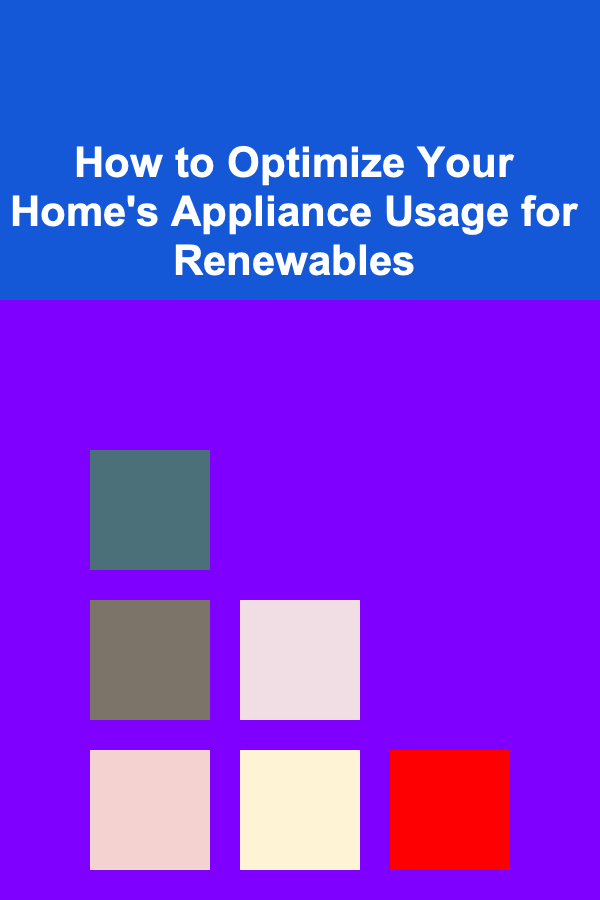
How to Optimize Your Home's Appliance Usage for Renewables
ebook include PDF & Audio bundle (Micro Guide)
$12.99$9.99
Limited Time Offer! Order within the next:

As the world continues to embrace renewable energy, optimizing the usage of home appliances to align with sustainable energy sources has never been more important. Integrating renewable energy into our daily lives is not only an eco-friendly choice, but it also offers significant savings on energy bills in the long run. By understanding how to efficiently use appliances, homes can maximize renewable energy benefits while reducing reliance on non-renewable resources. In this article, we will explore the strategies, tools, and habits that can help homeowners optimize their appliance usage for renewables.
The Role of Renewables in the Home
Renewable energy sources, such as solar, wind, and hydropower, are increasingly being used to power homes worldwide. Solar panels, for instance, are becoming a common feature in many residential properties, allowing homeowners to generate their own electricity from sunlight. Wind and hydropower solutions are also being explored, depending on geographic and environmental conditions. These renewable sources are not only environmentally friendly but can also be economically advantageous as energy costs continue to rise.
However, the challenge lies in how to effectively manage and utilize the energy produced by these renewable sources. Unlike traditional energy grids, which provide a constant and reliable supply of electricity, renewable sources like solar and wind are intermittent. Solar energy is only available during the day, and its output can vary with weather conditions. Wind energy is similarly unpredictable, depending on local wind patterns. Therefore, optimizing the usage of household appliances in conjunction with renewable energy is essential for maximizing the benefits of these green energy sources.
Understanding the Basics of Energy Efficiency
Before diving into specific strategies for optimizing appliance usage, it's important to understand the concept of energy efficiency. In simple terms, energy efficiency means using less energy to perform the same tasks. Appliances that are energy efficient consume less electricity, helping to reduce overall energy consumption and lower carbon footprints.
Energy-efficient appliances are typically marked with certifications like ENERGY STAR, which indicates that the appliance meets certain energy efficiency standards. These appliances are designed to minimize energy waste, often through innovations in technology that allow them to perform their functions while consuming less power.
When integrating renewable energy sources into a home, choosing energy-efficient appliances is the first step towards optimizing appliance usage. But beyond purchasing efficient devices, homeowners need to adopt strategies that take into account the variable nature of renewable energy.
The Interplay of Renewable Energy and Appliance Usage
To make the most of renewable energy, it's crucial to understand the way your appliances interact with the energy grid and your home's renewable energy production. Here are a few key factors that influence how appliances use energy:
1. Energy Demand of Appliances
Different appliances consume varying amounts of energy depending on their functions. For example, air conditioning units, water heaters, and refrigerators tend to use a significant amount of energy compared to smaller devices like lights and televisions. Understanding the energy demand of each appliance is important for deciding which ones to prioritize for renewable energy usage.
2. Time-of-Use Energy Generation
Since renewable energy sources like solar and wind are intermittent, it's important to consider when these sources are most abundant. Solar panels generate the most energy during peak sunlight hours, which are usually from 9 a.m. to 3 p.m. Wind energy may fluctuate throughout the day, depending on the location. By adjusting the usage of high-energy-demand appliances to these peak generation times, homeowners can reduce their reliance on the grid and maximize their renewable energy production.
3. Energy Storage Solutions
Energy storage systems, such as batteries, are key to optimizing renewable energy use in the home. When renewable energy sources generate more electricity than is being used, the excess energy can be stored in batteries for later use. This allows homeowners to use stored energy during times when renewable sources are not generating enough power, such as at night or on cloudy days. Optimizing appliance usage to coincide with energy storage capabilities is a crucial aspect of maximizing renewables.
Strategies for Optimizing Appliance Usage with Renewables
1. Shift High-Energy Tasks to Peak Generation Times
The simplest way to optimize appliance usage for renewables is by timing high-energy tasks to coincide with peak renewable energy generation. For homes powered by solar energy, this means using major appliances like washing machines, dishwashers, or electric ovens during the day, particularly when the sun is shining. Similarly, for homes with wind power, it's best to use high-energy appliances when wind conditions are favorable.
Example Schedule for Solar-Enabled Homes:
- 9 a.m. to 3 p.m.: Run washing machines, dishwashers, dryers, and other high-demand appliances while solar energy is plentiful.
- 6 p.m. to 9 p.m.: Use stored energy for lighting and less energy-intensive tasks, such as cooking or watching television.
2. Invest in Smart Appliances and Home Automation Systems
Smart appliances are designed to optimize energy usage by automatically adjusting their functions based on energy availability. These appliances can be connected to home automation systems that monitor the home's energy production and adjust appliance usage accordingly. For instance, a smart thermostat can adjust heating and cooling based on solar energy generation, while smart refrigerators can automatically enter energy-saving modes when the renewable energy output is low.
In addition to smart appliances, home energy management systems (HEMS) can help homeowners monitor energy production and consumption in real-time, providing insights into which appliances are consuming the most power and when. This data allows homeowners to make informed decisions about when to use certain appliances, helping them to sync appliance usage with renewable energy production.
3. Use Energy Storage Systems Effectively
For homes with energy storage systems, such as solar batteries, managing the timing of energy use is crucial. The goal is to minimize the use of grid electricity by relying on stored renewable energy during off-peak hours. Here's how to do it:
- Charge during the day: Use excess solar energy during the day to charge your storage system. When the sun is shining and energy demand is low, your battery will store excess energy that can be used later.
- Discharge during high-demand periods: Use stored energy during the evening or on cloudy days when renewable energy production is low. By doing so, you reduce your reliance on the grid and make the most of your energy storage investment.
Energy storage systems can also be used in combination with appliances that have flexible energy demands, such as electric vehicles (EVs) or water heaters. By charging EVs during the day or running water heaters when renewable energy is abundant, homeowners can reduce their dependence on grid electricity.
4. Upgrade Insulation and Improve Energy Efficiency
Optimizing appliance usage isn't just about when to use them---it's also about ensuring that your home retains the energy it generates. Proper insulation, energy-efficient windows, and air sealing can significantly reduce the energy needed for heating and cooling, making it easier to manage renewable energy production.
By reducing overall energy consumption, homeowners can ensure that they are using renewable energy more efficiently, even when it's not abundant. For instance, by keeping a home well-insulated, less energy will be required to heat or cool the space, meaning more renewable energy can be used for other tasks, like powering appliances.
5. Regular Maintenance of Appliances and Renewable Systems
To ensure that renewable energy is being used as efficiently as possible, regular maintenance of both appliances and renewable energy systems is essential. Solar panels, for example, should be cleaned and inspected regularly to ensure maximum energy generation. Likewise, high-efficiency appliances should be maintained to continue operating at optimal levels.
For homes with wind turbines or hydroelectric systems, regular check-ups ensure that they are performing at their best, providing homeowners with consistent renewable energy.
The Future of Appliance Usage and Renewables
As renewable energy technology continues to improve, the future of appliance usage in homes will become even more intertwined with green energy. Advances in energy storage, smart home systems, and appliance efficiency will allow for even more seamless integration of renewable energy into daily life.
For instance, new developments in solar technology are making panels more efficient and affordable, while innovations in battery storage are reducing costs and increasing capacity. These advancements will make it easier for homeowners to optimize their appliance usage for renewables, leading to even greater savings on energy costs and a more sustainable lifestyle.
Conclusion
Optimizing appliance usage for renewables is a crucial step towards a more sustainable and energy-efficient future. By shifting high-energy tasks to peak renewable generation times, investing in smart appliances and home automation systems, and using energy storage effectively, homeowners can maximize the potential of their renewable energy systems while minimizing their reliance on the grid. As renewable energy technology continues to evolve, the opportunities for optimizing home appliances for green energy will only continue to grow, helping to create a more sustainable and energy-efficient world.

Essential Guide to Saving Money on Home Internet Security While Staying Safe
Read More
How to Organize a Family Picnic in Your Backyard
Read More
How to Organize a Themed Brunch Party at Home
Read More
How to Track Your Gardening Goals and Achievements
Read More
How to Explore Blockchain for Intellectual Property
Read More
Understanding Cryptocurrency Futures and Options: A Deep Dive
Read MoreOther Products

Essential Guide to Saving Money on Home Internet Security While Staying Safe
Read More
How to Organize a Family Picnic in Your Backyard
Read More
How to Organize a Themed Brunch Party at Home
Read More
How to Track Your Gardening Goals and Achievements
Read More
How to Explore Blockchain for Intellectual Property
Read More